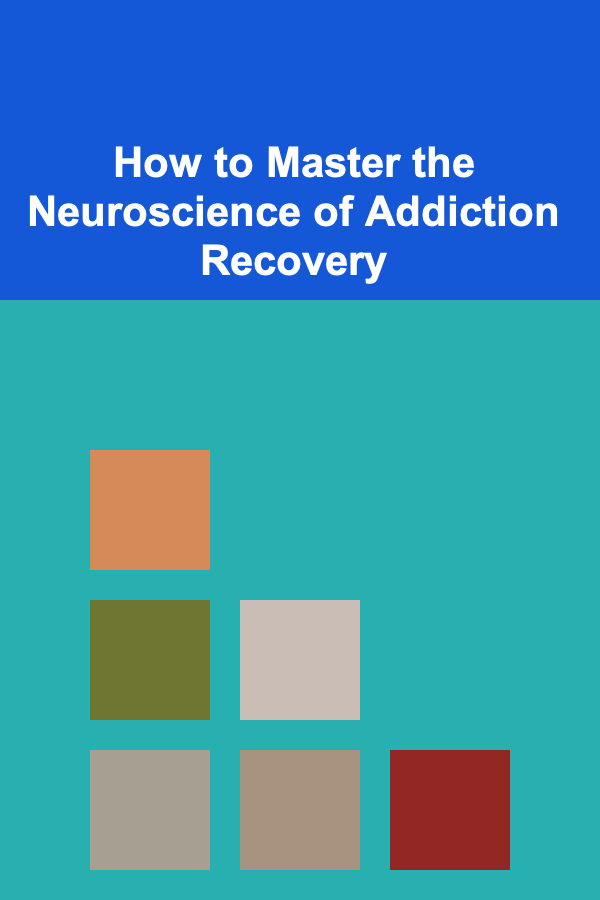
How to Master the Neuroscience of Addiction Recovery
ebook include PDF & Audio bundle (Micro Guide)
$12.99$8.99
Limited Time Offer! Order within the next:

Addiction is a complex, multifaceted disorder that affects the brain, behavior, and body. The journey to recovery from addiction involves understanding its roots, the underlying mechanisms at play in the brain, and how we can rewire the brain for lasting change. One of the key approaches to mastering addiction recovery is to delve into the neuroscience behind addiction and utilize that knowledge to implement strategies that promote healing and transformation. In this article, we will explore the neurological processes of addiction, how these processes impact behavior, and the science-backed methods for effectively overcoming addiction.
Understanding Addiction from a Neuroscientific Perspective
The Brain and Addiction
At its core, addiction is a brain disorder. Neuroplasticity, the brain's ability to reorganize itself by forming new neural connections, plays a critical role in addiction. When someone becomes addicted, their brain chemistry, neural circuits, and behavior are altered in ways that perpetuate compulsive substance use or behaviors. The brain's reward system, which is responsible for feelings of pleasure and motivation, is particularly involved in addiction.
The primary area of the brain that is affected by addiction is the dopamine system. Dopamine is a neurotransmitter that plays a key role in the reward system. When we engage in activities that promote survival or well-being---such as eating, socializing, or exercising---the brain releases dopamine, creating feelings of pleasure and reinforcing the behavior. However, addictive substances or behaviors trigger an unusually high release of dopamine, leading to intense feelings of pleasure. Over time, the brain becomes reliant on the substance or behavior to release dopamine, which leads to an increase in cravings and compulsive behavior.
The Reward Pathway
The reward pathway in the brain consists of several key structures, including the ventral tegmental area (VTA) , the nucleus accumbens (NAc) , and the prefrontal cortex (PFC). The VTA produces dopamine and releases it into the NAc, which is often referred to as the brain's pleasure center. The PFC, which is responsible for decision-making and impulse control, is involved in regulating the reward pathway. Addiction occurs when this system becomes dysregulated, leading to an overwhelming desire to repeat the behaviors that trigger the dopamine release.
When someone repeatedly engages in substance use or addictive behaviors, their brain's reward pathway becomes overstimulated. The mesolimbic dopamine system , which regulates motivation and reward, becomes hypersensitive, making the individual more prone to cravings. Over time, the brain adapts to these intense dopamine surges by reducing its natural dopamine production, leading to tolerance. This means that over time, the individual needs to consume more of the substance or engage in the behavior more frequently to achieve the same pleasurable feeling, creating a cycle that is difficult to break.
Neuroadaptation in Addiction
Neuroadaptation refers to the brain's ability to adjust to repeated stimuli. In the case of addiction, neuroadaptation occurs when the brain's response to substances or behaviors becomes diminished, requiring more of the substance or behavior to produce the same effect. This phenomenon is referred to as tolerance, and it is a hallmark of addiction.
However, the process of addiction does not stop with tolerance. The brain also undergoes neuroplastic changes , which means that the neural circuits involved in the addiction become stronger and more ingrained. This creates a pattern of compulsive behavior that is difficult to break. For example, drug use might become associated with specific environmental cues---such as a particular place, time of day, or people---creating an environmental trigger that reinforces the addictive behavior.
Additionally, withdrawal symptoms occur when the addictive substance is no longer present, causing an imbalance in the brain's chemistry. Withdrawal symptoms can include anxiety, depression, irritability, and intense cravings. These symptoms arise because the brain's reward system has become reliant on the substance, and without it, the individual experiences a chemical imbalance.
The Role of Stress and the Brain in Addiction
Chronic stress is another important factor that can contribute to addiction. Stress activates the hypothalamic-pituitary-adrenal (HPA) axis, which is responsible for the body's stress response. When a person is under chronic stress, their HPA axis remains overactive, which can lead to dysregulation of the reward system and an increased vulnerability to addiction.
The amygdala, a brain region associated with fear and emotional processing, also plays a role in addiction. When someone experiences high levels of stress or trauma, the amygdala can become overactive, heightening feelings of anxiety and emotional distress. This emotional turmoil can drive individuals to seek out substances or behaviors that provide temporary relief, further reinforcing the cycle of addiction.
The Science of Addiction Recovery
Understanding the neuroscience of addiction is crucial for developing effective strategies for recovery. Recovery is not simply about stopping a behavior---it involves rewiring the brain to restore balance and health. Here, we will explore evidence-based methods for overcoming addiction, grounded in the principles of neuroscience.
1. Neuroplasticity and Rewiring the Brain
One of the most powerful tools in addiction recovery is neuroplasticity, the brain's ability to reorganize and form new neural connections. Recovery involves rewiring the brain's neural circuits to replace addictive behaviors with healthier ones.
Cognitive Behavioral Therapy (CBT)
Cognitive Behavioral Therapy (CBT) is a form of psychotherapy that focuses on changing negative thought patterns and behaviors. Research has shown that CBT can help individuals identify the triggers for their addiction and develop healthier coping mechanisms. By challenging the automatic thoughts and behaviors associated with addiction, CBT helps individuals rewire their brain to make better decisions and resist cravings.
Mindfulness-Based Stress Reduction (MBSR)
Mindfulness-Based Stress Reduction (MBSR) is another therapeutic approach that has shown promise in addiction recovery. MBSR involves cultivating awareness of the present moment without judgment. Studies have shown that mindfulness practices can increase prefrontal cortex activity, which enhances impulse control and decision-making. By practicing mindfulness, individuals can learn to observe cravings without acting on them, reducing the likelihood of relapse.
2. The Role of the Prefrontal Cortex
The prefrontal cortex (PFC) is the brain's executive control center, responsible for decision-making, impulse control, and future planning. Addiction hijacks the PFC, impairing its ability to regulate behavior and make decisions. Therefore, strengthening the PFC is a key component of recovery.
Exercise and the Prefrontal Cortex
Exercise has been shown to improve prefrontal cortex functioning. Physical activity increases blood flow to the brain, stimulates the growth of new neurons, and enhances cognitive function. Regular exercise can help restore the brain's ability to make rational decisions and control impulses, which are crucial for maintaining long-term recovery.
Behavioral Interventions and PFC Activation
Behavioral interventions that encourage goal-setting, delayed gratification, and self-control can also help activate the prefrontal cortex. These interventions help individuals strengthen their cognitive abilities and develop a greater sense of control over their behavior, which is essential for resisting the urges of addiction.
3. Reward System Regulation
In addiction recovery, one of the primary goals is to restore balance to the brain's reward system. The addiction-reward cycle relies on an overstimulation of the reward pathway, which leads to compulsive behavior. To break this cycle, it is necessary to engage in healthy activities that stimulate the reward system in a balanced and sustainable way.
Engaging in Healthy Rewards
Instead of turning to addictive substances or behaviors for pleasure, individuals in recovery can focus on healthier rewards, such as exercise, socializing, pursuing hobbies, or creative activities. These activities can activate the brain's reward system in a more balanced way, providing a sense of satisfaction without the harmful consequences of addiction.
Dopamine and Reward Habituation
Recovery often involves learning to experience pleasure and reward in a more natural way, without relying on the artificial high that addiction provides. This process, known as reward habituation, occurs as the brain begins to recalibrate its response to natural rewards. Over time, the individual can learn to experience joy and fulfillment from everyday activities, restoring balance to their brain chemistry.
4. Social Support and the Brain
Social connections play a crucial role in addiction recovery. The brain is wired for social interaction, and oxytocin, a hormone associated with bonding and connection, plays a role in reducing stress and promoting emotional well-being. Social support from family, friends, and support groups can provide a sense of belonging, reduce isolation, and foster positive emotional states, all of which are important for sustaining recovery.
5. Medication-Assisted Treatment (MAT)
In some cases, medication-assisted treatment (MAT) may be necessary to aid in addiction recovery. MAT involves the use of medications that help to manage withdrawal symptoms, reduce cravings, and restore brain chemistry. Medications like methadone , buprenorphine , and naltrexone can help individuals maintain stability in the early stages of recovery and prevent relapse.
6. Addressing Co-Occurring Mental Health Disorders
Many individuals with addiction also suffer from co-occurring mental health disorders, such as depression, anxiety, or trauma-related disorders. These conditions can complicate recovery and require targeted treatment. Treating both addiction and mental health issues concurrently is crucial for long-term success. Dual diagnosis treatment incorporates both psychotherapy and medication to address the interconnectedness of addiction and mental health.
The Future of Addiction Recovery: Advances in Neuroscience
As our understanding of the brain continues to evolve, new and innovative treatment options for addiction recovery are emerging. Advances in neuroimaging , genetic research , and neurogenesis (the growth of new brain cells) are paving the way for more personalized and effective interventions.
The future of addiction recovery will likely involve a combination of pharmacological, behavioral, and brain-training approaches, all tailored to the individual's unique brain chemistry and needs. Furthermore, ongoing research into the role of epigenetics (how environment influences gene expression) in addiction may offer new insights into prevention and treatment strategies.
Conclusion
Mastering the neuroscience of addiction recovery involves understanding the complex interactions between the brain, behavior, and environment. Addiction is not just about willpower or choice---it is a neurological condition that requires a comprehensive approach to healing. By harnessing the power of neuroplasticity, strengthening the prefrontal cortex, regulating the reward system, and engaging in evidence-based therapeutic interventions, individuals can rewire their brain for lasting recovery. With the continued advancement of neuroscience, the future of addiction recovery looks promising, offering hope for those seeking to break free from the grip of addiction.
Reading More From Our Other Websites
- [Personal Investment 101] How to Create AI-Driven Products That Generate Ongoing Revenue
- [Home Lighting 101] How to Light Your Home Office for Maximum Productivity
- [Personal Investment 101] How to Use Value Investing to Find Undervalued Stocks
- [Home Staging 101] How to Use Lighting to Enhance the Staging of My Home
- [Personal Care Tips 101] How to Apply Hair Mousse for Maximum Volume
- [Home Maintenance 101] How to Inspect and Maintain Your Home's Foundation for Long-Term Health
- [Polymer Clay Modeling Tip 101] From Imagination to Reality: Fun Themes for Kids' Polymer Clay Creations
- [Home Rental Property 101] How to Handle Lease Renewals with Tenants
- [Metal Stamping Tip 101] Top 5 Design Tips to Maximize Efficiency in Small-Batch Metal Stamping
- [Home Lighting 101] How to Use Ceiling Lamps to Elevate Your Home's Design

How to Build a Profitable Website Auditing Business from Home
Read More
How to Choose the Best Holiday Candles for Your Decor
Read More
How to Prevent Fleas and Ticks in Your Home
Read More
How to Safely Travel with Your Pet Around the House
Read More
How to Set Up a Checklist for Organizing School Documents and Paperwork
Read More
How To Master Extreme Kayak Surfing
Read MoreOther Products

How to Build a Profitable Website Auditing Business from Home
Read More
How to Choose the Best Holiday Candles for Your Decor
Read More
How to Prevent Fleas and Ticks in Your Home
Read More
How to Safely Travel with Your Pet Around the House
Read More
How to Set Up a Checklist for Organizing School Documents and Paperwork
Read More